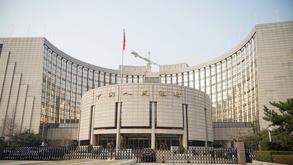 This undated photo shows the headquarters of the People's Bank of China in Beijing. (PHOTO / XINHUA)
This undated photo shows the headquarters of the People's Bank of China in Beijing. (PHOTO / XINHUA)
China has introduced more substantial financial measures to stabilize economic growth given a resurgence in COVID-19 cases, as industry insiders understand it will serve as fresh impetus to the world economy after the World Bank slashed global growth forecasts due to heightened geopolitical tensions.
The World Bank lowered the global growth forecast to 3.2 percent from 4.1 percent on Monday, mainly due to the Russia-Ukraine conflict and debt-ridden low-income countries. The World Bank's board will discuss a 15-month, $170 billion funding package to cover April 2022 through June 2023, exceeding the $157 billion laid out for pandemic relief.
The People's Bank of China, the nation's central bank, together with the State Administration of Foreign Exchange, jointly released 23 measures on Monday to help businesses affected by the latest surge in COVID-19 cases to improve domestic economic circulation and facilitate exports
At the same time, the People's Bank of China, the nation's central bank, together with the State Administration of Foreign Exchange, jointly released 23 measures on Monday to help businesses affected by the latest surge in COVID-19 cases to improve domestic economic circulation and facilitate exports.
Starting from 2022, the 400 billion yuan ($63 billion) inclusive relending fund that especially targets micro and small enterprises will continue to be used on a rolling basis, and the quota can be expanded if necessary, the newly released measures said.
Peng Lifeng, deputy head of the Financial Market Department at the central bank, said more support will favor companies, industries and areas affected by the epidemic. Financial institutions should extend and resume loans for epidemic-hit people in a more flexible manner.
The National Bureau of Statistics said on Monday that China's GDP growth rate reached 4.8 percent in the first quarter, up from 4 percent in the fourth quarter.
READ MORE: PBOC conducts reverse repos to maintain liquidity
However, retail sales in March were affected by COVID-19 cases, and this caused a decline, for the first time since July 2020, of 3.5 percent year-on-year. The cumulative funding for real estate development plunged 19.6 percent last month, touching a record low.
Wang Qing, chief macroeconomic researcher at Golden Credit Rating, called for more supportive policies, such as lowering the policy rate in the second quarter, to boost the property market, which has significantly weighed on economic growth.
There is still much room for an adjustment in monetary and fiscal policies, including the injection of more liquidity, lowering tax and reducing fees to address the negative impact of the epidemic, he added.
The central bank has stepped up its support for the real economy. On Friday, it announced a 0.25 percentage point reduction of the reserve requirement ratio, injecting 530 billion yuan of liquidity into the market. To facilitate the accelerated implementation of tax rebates for small and micro enterprises, the central bank submitted 600 billion yuan to the central budget by mid-April, which is equal to lowering the RRR by 0.25 percentage point.
ALSO READ: RRR cut seen on the horizon
The central government also announced on Monday the launch of a 100 billion yuan relending facility to support the transportation and logistics sector and another 200 billion yuan relending fund to boost technology innovation.
Wei Jianguo, vice-chairman of the China Center for International Economic Exchanges, said during an economic forum on Monday that China's export readings are expected to pick up in the second and third quarter of the year, serving as a major economic driver and alleviating downward pressure on the economy to some extent.
Monica Li, equities director at Fidelity International, said it is more important to find "organic economic growth momentum" when faced with short-term difficulties and uncertainties. The stabilization of new mid- to long-term corporate loans in March, and accelerated underwriting in green, micro, infrastructure and long-term manufacturing loans are some of the best examples.


